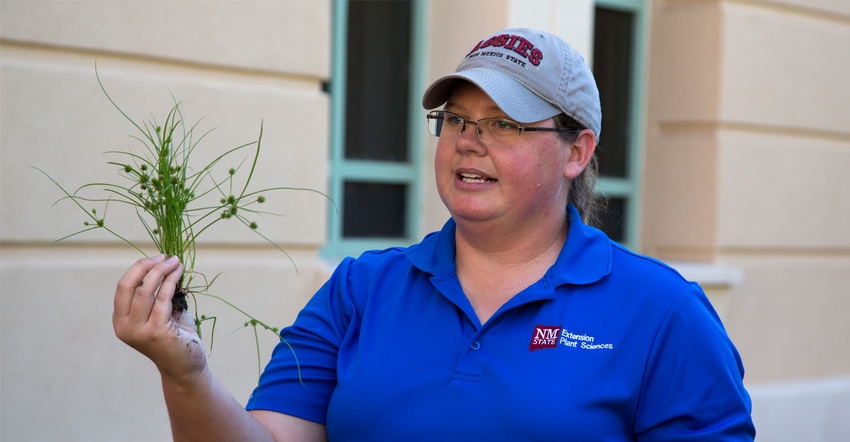
It’s been said, the early bird gets the worm. In weed management, the early bird catches the weed while it’s still small, according to a New Mexico State University Extension weed specialist.
“Whether you are pulling a weed out of the ground or paying someone else to do it, running over it with the tractor tilling it up, or hitting it with a herbicide, what’s easier to control— a weed inches tall or a weed that's as tall as me? A root system inches deep or a root system that can go several feet into the ground?” asks Dr. Leslie Beck, Extension weed specialist. “The smaller the weed, the easier it is to control.
“Easier said than done, right?”
WHAT'S THE BIG DEAL
One of the questions Beck says she is frequently asked by people outside of agriculture is: “What’s the big deal about weeds?”
“Weeds have deep, extensive tap root systems that can steal water and nutrients away from plants. They can quickly become established, grow tall, and shade out some of your crops,” she says. “They also can attract insect and disease pests which further damage crop quality and reduce yield.”
But in weed management, while herbicide chemistry is important, Beck says knowing the biology of the weed is essential for successful control, which begins with accurate weed identification.
“Once you identify the weed, you can begin to build your strategy."
For example, one of our most notorious weeds is field bindweed. “It can climb up your plants, tighten and actually break them in half. It’s very violent in the weed world,” Beck says.
Next, it's important to know when that weed is actively growing, she says.
“We need to know when to expect it to start germinating in our field because what are we aiming for? To control the weeds when they're young. We also need to know what it is about the biology of that weed we are going to have to target as managers.”
Another consideration is its ability to produce large quantities of seed, especially with annual weeds like Russian thistle and kochia. “A few bindweed plants can produce about a hundred seeds in a growing season,” she explains. “Not much, right? Every single one of those seeds can survive up to 70 years in the soil before it ever produces a plant.”
When it comes to weed management, Beck urges growers to be more concerned with what’s below the soil than what's above. Bindweed’s root system can go down 60-feet deep in the soil and spread another 30 feet through rhizomes, helping the weed steal water and nutrients from the crop and making successful control much more difficult, she says.
“In other words, weeds are extremely good at what they do. What's important to understand about weed management is that no one weed management practice by itself is going to be successful in a sustainable way. What happens when you till it under? They grow back, right? What happens if you find that one herbicide that's going to work and kill every single weed in your field, what do you have to keep doing? Applying it, applying it, applying it. That’s what we are seeing with glyphosate (Roundup.) What’s the problem with glyphosate? Resistance. We are too dependent on that one tool to manage a wide variety of our weeds.”
Which is why Beck recommends growers utilize an Integrated Pest Management (IPM) strategy, combining as many practices as possible to cause more injury to the weed. “The more injury you cause, and the more sustainable that injury is, the easier it is on you and the more successful you're going to be with your management.”
WEED BIOLOGY
The biology of the weed is also essential in determining appropriate herbicide application if the target weeds have already matured.
With bindweed, most people might say summer is the most appropriate time to spray, but Beck disagrees. “I would say in the spring or the fall because we are concerned about what’s below the soil, and the only way we are going to affect what's below is to make an application when the plant is actively growing. So, what is it doing in the spring? It's growing back from the root system. If we disrupt that, it can’t photosynthesize and it's having to use more of that underground root structure to recover.
“In the fall, field bindweed knows winter is coming, so it's moving all of its carbohydrates into its root system. If we make a herbicide application then, where’s our herbicide application going to go? It’s going to move more effectively within a plant and it's going to affect more of the root system. When you're dealing with a root system that’s 60-feet deep, that's the only thing you can do.”
IPM STRATEGY
When following an IPM strategy, especially with herbicide applications or general weed management, growers also need to consider the other weeds surrounding their system, and not necessarily only within their field.� “If we have weeds coming up along roadsides and in irrigation canals, what happens to the corn plant or the cotton plants nearby? It’s likely the weed system is going to move back into our field,” says Beck.
“So, we can utilize all the management we can in these fields, but if we have weeds producing seed that can travel a significant distance, then we are dealing with this same weed population over and over again.”
Finally, Beck says, read and follow the label. “Read the label. Read the label. Not only is it the law, but everything you need to make safe and successful application is in the label.”
About the Author(s)
You May Also Like






